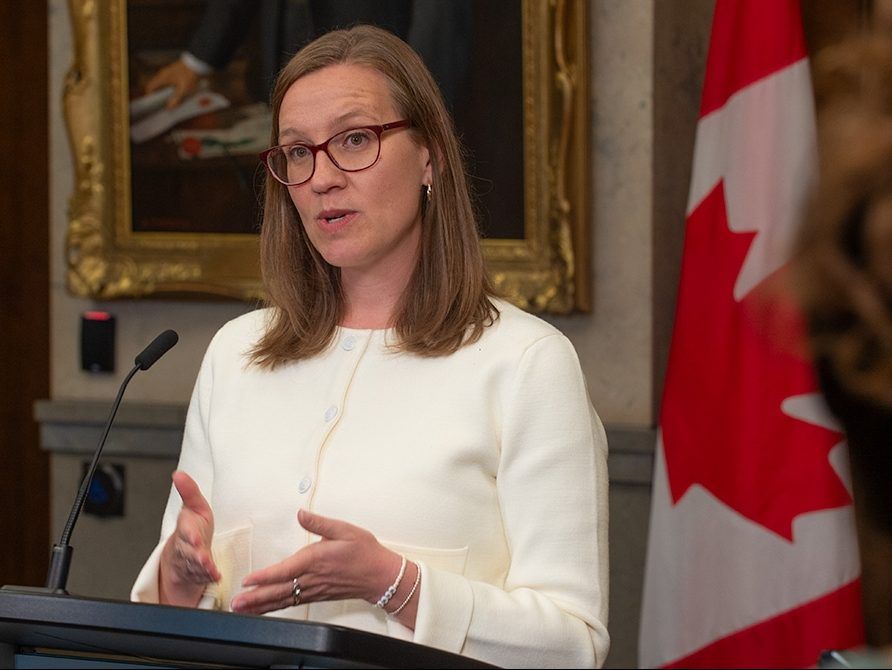A new report recommends changes to how OCDSB elementary schools deliver French immersion, phasing out some special needs programs and more.
Get the latest from Joanne Laucius straight to your inbox
Published Jan 10, 2025 • Last updated 0 minutes ago • 6 minute read

A report released Friday by Ottawa’s largest school board has recommended extensive changes to elementary programs, including changes to French immersion and phasing out alternative schools and some programs for children with special needs.
Among the changes: three French options — core English, early immersion and middle immersion — have been whittled down to two.
Advertisement 2
THIS CONTENT IS RESERVED FOR SUBSCRIBERS ONLY
Subscribe now to read the latest news in your city and across Canada.
- Exclusive articles from Elizabeth Payne, David Pugliese, Andrew Duffy, Bruce Deachman and others. Plus, food reviews and event listings in the weekly newsletter, Ottawa, Out of Office.
- Unlimited online access to Ottawa Citizen and 15 news sites with one account.
- Ottawa Citizen ePaper, an electronic replica of the print edition to view on any device, share and comment on.
- Daily puzzles, including the New York Times Crossword.
- Support local journalism.
SUBSCRIBE TO UNLOCK MORE ARTICLES
Subscribe now to read the latest news in your city and across Canada.
- Exclusive articles from Elizabeth Payne, David Pugliese, Andrew Duffy, Bruce Deachman and others. Plus, food reviews and event listings in the weekly newsletter, Ottawa, Out of Office.
- Unlimited online access to Ottawa Citizen and 15 news sites with one account.
- Ottawa Citizen ePaper, an electronic replica of the print edition to view on any device, share and comment on.
- Daily puzzles, including the New York Times Crossword.
- Support local journalism.
REGISTER / SIGN IN TO UNLOCK MORE ARTICLES
Create an account or sign in to continue with your reading experience.
- Access articles from across Canada with one account.
- Share your thoughts and join the conversation in the comments.
- Enjoy additional articles per month.
- Get email updates from your favourite authors.
THIS ARTICLE IS FREE TO READ REGISTER TO UNLOCK.
Create an account or sign in to continue with your reading experience.
- Access articles from across Canada with one account
- Share your thoughts and join the conversation in the comments
- Enjoy additional articles per month
- Get email updates from your favourite authors
Sign In or Create an Account
or
Article content
Some programs, including the alternative program and middle French immersion, will be discontinued.
More students will go to a school in or near their neighbourhood. The grade configurations in some schools may change — which could result in changes to school names.
And yes, some students will have to change schools — although it’s still unclear how many.
The OCDSB announced the elementary review last spring. The goal is to keep as many students as possible in neighbourhood schools and to ensure equity and accessibility.
As it stands, some elementary schools have more than 900 students or fewer than 200, which has caused inequities between schools and students.
Some schools, often those that don’t offer French immersion, have low enrolment. Students from newcomer and low-income families were less likely to enroll in French immersion. Some educators have argued that “streaming” students at a young age was discriminatory because it forces families to make decisions with little opportunity to change their pathway once a decision has been made.
One of the goals of the review is to be able to offer programming in French at each school and to offer enough support at each school for students with special needs.
Advertisement 3
Article content
There’s a lot to unpack. Here’s a first glimpse at the changes being proposed:
How would French immersion change under the recommendations?
As it stands, some OCDSB schools offer only French immersion, some offer only English with core French, and others offer both.
The proposed model would offer two pathways for elementary students: Enhanced English (EE) and French Immersion (FI). Kindergarten students would continue to receive a 50-50 bilingual program.
In Grade 1, students would enter either EE or FI. However, the program would be “fluid” so that students could start a program as late as Grade 3. Entering the program after Grade 3 may be approved on a case-by-case basis — for example, students who have come from a French-language school.
There would be more English instruction in Grade 1 for FI students, increasing from 20 per cent English to 40 per cent English. There would be no change in Grades 2 through 8.
EE students would get more French, increasing from 220 minutes a week to 240 minutes.
The Middle French Immersion option will be discontinued for new students. The Grade 4 entry point would no longer be available starting in September 2026.
By signing up you consent to receive the above newsletter from Postmedia Network Inc.
Article content
Advertisement 4
Article content
At schools where there is both EE and FI, students in both programs may be combined in math and English classes. That would offer benefits to all students, including “ensuring that students attending the same school have an opportunity to learn and engage with peers across the programs,” the report said.
Will more students with special needs be integrated into classrooms?
A: This question has already stirred up controversy, with some families expressing concerns that their children would be removed from segregated classrooms where they are thriving.
The majority of students with special education needs are currently getting supports in general classrooms, the report said.
Some students with special needs get support from teams outside their classroom, but in their school. Others are in specialized program classes, usually at a location outside the community. The report said special education at the OCDSB was last reviewed in 2010 and the approach has changed from “sorting” students according to ability.
There are 11 specialized program classes with 142 classes at the OCBD. The report recommends keeping some and phasing out others.
Advertisement 5
Article content
Among the programs on the “keep” list:
- the autism spectrum disorder program;
- the behaviour intervention program;
- the deaf/hard of hearing program;
- the developmental disabilities program, including semi-integrated specialized sites;
- the physical support program;
- and the junior/intermediate gifted program.
Among the programs on the “phase out” list:
- the primary special needs program, which has seven classes with 10 students;
- the junior general learning program, which has six classes with 16 students;
- the primary and junior language learning disabilities program, which has 11 classes with 10 students;
- the junior and intermediate learning disabilities semi-integrated program, which has 14 classes with eight students;
- the primary gifted program, which has one class with up to 20 students.
In total, 39 classes would be affected.

What will happen to alternative schools?
A: The OCDSB has four alternative elementary schools (Lady Evelyn, Riverview, Churchill and Regina Street) and one middle school (Summit) that focus on the student-centred “alternative” learning approach. This was once a little outside the educational mainstream.
Advertisement 6
Article content
However, the tenets of that philosophy are “now generally consistent with the commonly-held principles of sound pedagogy and which are already in place in many schools,” the report said.
More information about what will happen to students already enrolled in the alternative program is to be presented in a report to be released in advance of the March 4 school board meeting.
Will schools be closed if the recommendations are implemented?
The report does not recommend closing schools.
“All schools will remain open and have a catchment area that will, to the extent reasonably possible, provide the best opportunity for appropriate and sustained enrolment.”
However, given the sweeping scope of the recommendations, there will be planning and accommodation implications. Where possible, community schools will have both FI and EE programs, but some will offer only FI or EE, said the report.
Meanwhile, there may be fewer portables at older schools, said the report.
“Although there will always be some need to rely on portables in growth areas, there should be less reliance on portables (generally) in older facilities.”
Advertisement 7
Article content
How many students will change schools?
That’s not known. The report notes that in a normal transition year, between 6,000 and 8,000 students move schools. The changes to school boundaries and configurations will mean more students will move than is typical.
“While not insignificant, it is important to balance this one-time move against the numerous benefits of achieving a more equitable and accessible school system,” said the report.
A “school locator” that will allow families to identify their designated school will be released at the end of February.
Meanwhile, the groundwork is being laid for “more coherent families of schools,” said the report. That means, for the most part, cohorts of students moving schools — elementary to middle school, for example — will be kept together.
It also means that where school populations within a community are split between schools, there will be more cases where all of the students transition to the next school as a group.
How will this affect teachers and other staff?
The impact on staffing levels “will need to be further assessed,” said the report.
Advertisement 8
Article content
Phasing out the five types of specialized program classes will allow for 42 teachers and 13 education assistants to be moved over three years.
There will also be “fairly significant” staff movement, which will need to be managed by principals and unions.
What’s next?
Elected trustees must approve substantive changes to program delivery. Meanwhile, in the coming weeks, more information will be released and there will be opportunities for parents, students, staff and communities to provide feedback online and in person.
Is there even more to come?
Yes. The elementary program review is the first stage of a four-part, multi-year “vision exercise.”
The next stages include early years and childcare services, secondary programming, service delivery and support structures and adult and continuing education.
Recommended from Editorial
-

Nearly third of ODSCB schools below 'state of good repair,' watchdog says
-

Schoolyard scrap: Ottawa school board to pay for replacing play structures
Article content
.png)
 3 hours ago
8
3 hours ago
8




































 Bengali (BD) ·
Bengali (BD) ·  English (US) ·
English (US) ·